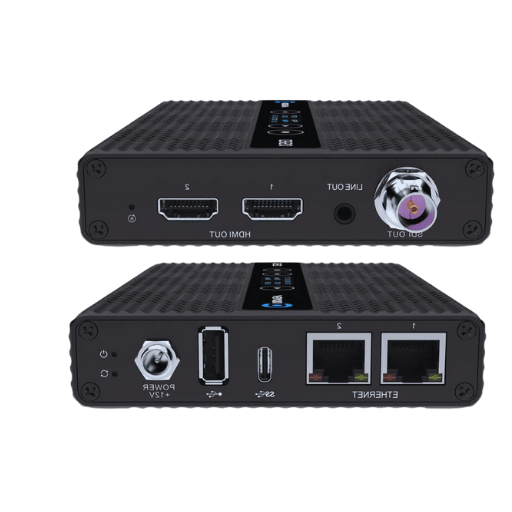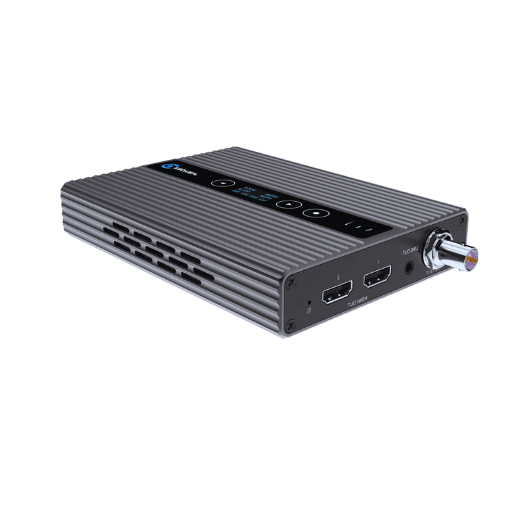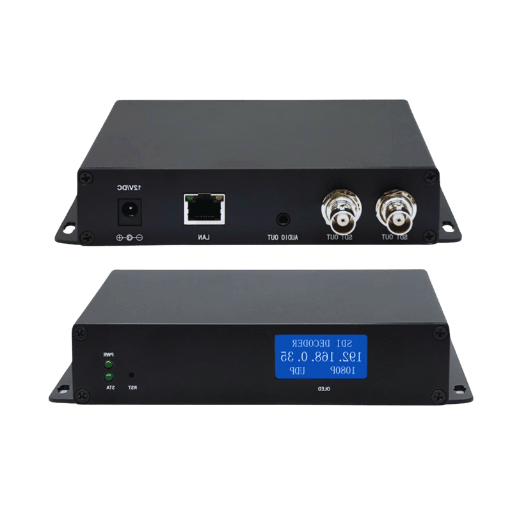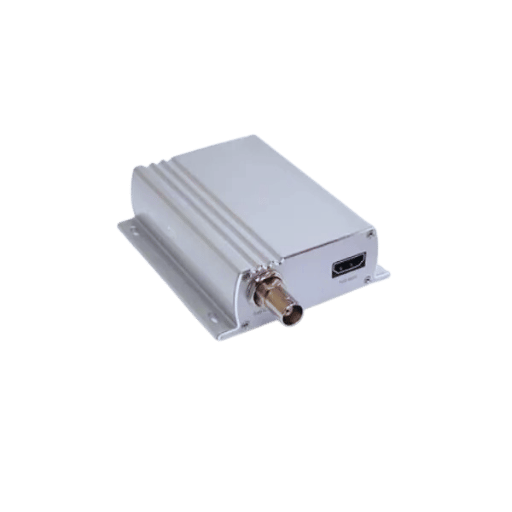The information and understanding of the basic building blocks necessary to display high-definition content on your screens will keep becoming a requisite as the need for ultra-modern visual demands increases. In this context, it becomes crucial to mention that the video decoder is indispensable, especially with 4K video and HDMI. This piece seeks to explain the design, primary purpose, and actual working parameters of 4K video decoder devices. It is possible to produce a comprehensive, informative resource for both professionals and amateurs of such devices by comprehensively studying the principles that allow those straightforward devices to change digital data into visible images with minimal degradation and delay. Suppose you are a technician installing and servicing multimedia systems or a customer who wants to improve the quality of a home theater. In that case, this guide will provide you with the basic knowledge about high-definition multimedia decoding.

Video decoders are the hardware or software used significantly for decoding and displaying the coded signals in the form of videos. Regarding 4K video over HDMI, the decoder accepts high-definition video data, which is often compressed using H264 or HEVC. The signal is decoded, and the video information integrated is modified in a manner that enables the reconstruction of the main idea of the content without any distortion. The procedure includes dividing the given input into various subgroups such as video data, sound data, and other information, coding the components, and putting everything together to play the video. Overall, the video decoder is of great importance and helps convert very sophisticated digital data and its comprehension into excellent graphical images for viewing purposes.
Essentially, a video decoder takes compressed digital information and renders it suitable for output on video screens. The process commences with demixing the multiplexed data streams to obtain separate video, audio, and text pieces. The decompression of video signals is then undertaken by the video decoder with the use of several standards like H.264 or HEVC. A presentation’s audio and video components must be perfectly synchronized since nobody would want to watch a movie with audio and video playing severally apart. Finally, by converting digital signals into high-performance and quality analog signals, the video decoder helps to ensure that the visual information is optimally transmitted and displayed in different application areas.
The video encoder and the video decoder are both important tools for enhancing the process of working with video within the digital sphere. This component converts raw video and audio data into a specific digital form, making storage or data transmission more effective. It uses compression standards like H.264 and HEVC, which are meant to cut down the size of files without lowering quality, thereby ensuring better images on the screen and less bandwidth consumption. In contrast, a video decoder works by extracting images and sounds from compressed or encoded files to watch the movie or program. The data was demultiplexed, processed, and reconstructed to allow for immediate display on different screens. As the encoders primarily focus on the data reduction rate and efficient use of the data rate, the decoders are concerned with the accurate time-bound reconstruction of the information to deliver relevant visuals. This difference forms the basis of the process or system referred to as the encoder-decoder model that is relevant in the distribution and consumption of digital video.
HDMI, which expands as the high-definition multimedia Interface, has significant importance in the video decoding process since it provides a single connector for high–quality video and audio signals within a single cable, clearing off excess wires while ensuring low distortion of signals. This interface has additional video format features of 720p, 1080p, and 4K UHD resolution and more in terms of screen compatibility. There is no distortion in the signals since the bandwidth permitted for HDMI is big enough to allow free transfer of actual compressed video and audio signals from the source to the screen’s display HD-quality video and sound. Moreover, HDMI incorporates technologies such as HDCP (High-Efficiency Digital Content Protection) that restrict usage and duplication of content by worldwide copyright laws. With its equally pivotal component of interconnection and standardization, HDMI is primarily responsive to the emergence of modern audio-visual systems through the need for efficient and ease-of-use integration for optimal performance.

One of the most common use-cases for a video decoder, like for instance an IP video decoder may include applications such as pipelines. Therefore, it becomes a necessity to consider some key important features to guarantee perfect performance based on one’s specific needs.
These fundamentals are the basic determinants in defining the video decoder’s fulfillment of device demands or the requirements of future technology advancement.
The major difference when one assesses 4K and HD video decoders is the degree of resolution that can be supported. The 4K TV decoders are meant to support ultra-high definition with a measurable amount of 3840 x 2160, which is four times more than the present resolution of standard HD, which is 1920 x 1080. In the case of the 4K decoders, it is easy to recognize their worth owing to the great number of pixels that makes materialized projections more appealing when image sharpness is very critical. Other than the resolution variations, it has been noted that 4K decoders also feature hefty processing requirements and higher bandwidth requirements to control the increased data. For that reason, while 4K decoders are suitable for the delivery of more quality picture images, their being on standard pictures defines them as being higher than their HD counterparts in terms of the hardware and network infrastructure. Whether or not to use any of the two will be determined by the target image quality, available system, and the finances to be spent.
Several factors are equally important regarding IP or analog video and its appropriate decoding strategy. Since IP video is based on networks, sending video information in a digital form is possible over IP-based networks. Such parameters include the available bandwidth, latency, and network support for RTSP or H.264 standards, among other highly used factors. Moreover, the scalability of IP systems acts as a benefit since it makes integration and provision for room to increase effortless.
On the other hand, regarding common practice, analog video decoding, such as coax, is more likely assessed using older systems, while the newer applications use HDMI and IP decoders for higher efficiency. Decoders should work with either NTSC or PAL systems, and some features will not be available, especially in the analog versions. There is a preference for analog decoding for old systems or some other specific purposes due to cost and ease of use over digital technology’s advantages. For this reason, the choice amid IP and analog video decoding in as much as systems are concerned should respect the current state of affairs, the vision for growth, and the task to be performed.

4K HDMI output has many advantages which improve the efficiency and the quality of the visual as well as operation. First and foremost, it provides images with ultra-high definition clarity, providing about four times the detail of 1080p resolutions. This leap in resolution makes it possible to produce more refined images with vivid colors and more details, resulting in better stability. HDR technology, in addition, allows for a greater color spectrum and a wider dynamic range, further elevating image quality. It’s possible to transfer audio and video signals in one cable, which decreases the amount of cables, making system setups easier. In addition, its application is not limited as modern display devices are available for 4K HDMI output. Based on these properties, 4K HDMI output can be determined as an ideal output option in areas with high demand for video content.
4K HDMI output’s easy connection to video streaming greatly improves performance and functionality. The most popular streaming services are also Netflix, YouTube, and Amazon Prime Video, which have begun to prepare for a dominant presence in 4K content distribution. Therefore, this integration helps eliminate lag and buffering while streaming high-quality audio and video. In addition, since these platforms also have 4K content included, users can easily appreciate the increased clarity and colors of the content when they hook up their devices through a 4K HDMI cable due to the large amount of over-the-top content available. Thus, both the market and the technology have gained with the tide and now provide consumers and business users with the high-resolution reminder industry’s ability to deliver content.
Incorporating an HDMI connection within video production elevates the quality of content owing to the use of high-definition quality audio and video signals that are not compressed. This results in high-definition visuals as well as sound, factors that are essential to effective content creation. More importantly, the type of content produced by HDMI technology is of advanced 4K and HDR technology, which provides better depth, contrast, and color to the images produced. Finally, despite the distance, workflow is well maintained due to the capability of HDMI to transmit signals over long distances without any disruption, thus suitable for studio or field work. These enhancements help streamline production processes and enhance the viewing experience for end users, which ultimately increases the quality of the final video output.

Decoding streams via RTSP, RTMP, or UDP requires specialized approaches depending on the environment. Why is RTSP primarily applicable in setting up and controlling media sessions between Kit endpoints? The protocol allows a user to play, pause, and even record a stream, which makes the protocol suitable for CCTV systems and for running live streams. RTMP was also invented by Adobe early, with low operational in live video areas rather than in static web content; since it is able to push video, audio, and data effectively, it’s been used in live streaming services. This is because the Protocol transmits information via bounded mode, therefore completing the requirements of streaming. Unlike all the other protocols, latency is lower because UDP is a connection-less protocol that transmits datagrams as packets. It can be used even when the network is under congestion, and some packets may be lost since the efficiency of transferring time-critical messages is desirable for VoIP and online games. Considering the peculiarities of each of these protocols, video decoders need to work with packet headers, buffer levels, and error control in order to maintain and assure the quality and integrity of the decoded stream going through all these protocols.
Compatibility with live video platforms requires that video decoders provide broad support of formats and protocols that are widely used in different streaming services. Such a device should be able to cope with several codecs like H.264 and H.265 (HEVC), and VP9, which are commonly used because of their highly efficient compression in most leading platforms like YouTube, Facebook Live, and Twitch. Worst of all, a formidable decoder has to be able to switch between different protocol implementations, not only between those but also between HLS and DASH, which adapt quality in regard to the environment so as to enhance a viewing experience. Moreover, support for cross-platform operability gives assurance that the decoder will operate with various operating systems and devices, an imperative feature for services looking forward to embracing a wide market. Last but not least, there is a need to follow the evolution of technology and any changes made on the platforms that facilitate streaming to enhance the compatibility of all elements involved and boost streaming efficiency.
One needs to indigenously incorporate output algorithms responsive to the devices’ processing capacities and display sizes to optimize video output on various devices. For instance, devices like mobile phones or high-definition television sets are built with different processing units and display technologies one requires. Therefore, employing the video decoder should ensure that the rendering can be done appropriately by choosing the fitting resolution and the various bit rates suitable for the device’s usage mode. Also, other techniques, such as adaptive streaming used in HLS and DASH, which allows a video to be played optimally on various devices by making real-time adjustments depending on the available network bandwidth or device performance, have also been integrated to enhance the delivery of the video. This ensures that the user experience remains optimal and consistent on all platforms.

In the process of configuring the hardware for advertisement display, a decoder needs to be patched with an advertisement integration system. Such a system must allow for adding, replacing, or covering an advertisement over the video content quite well. The decoder under consideration must cater for placement of various advertisement formats, that is, pre-roll, mid-roll, banner overlays advertising, that is aimed to be provided to the end user without disrupting their experience with the content. The integration also needs to support more specific advertising based on the target audience: gender, age or other user behavior. This is achievable through the available metadata in the video stream, whereby ads are programmed to come on appropriately or well-timed, eliminating wastage of ads.
As far as digital signage goes, video output optimization has to be done so that there are clearer and more appealing displays. This involves an alteration of the resolution, usually to high definition or even ultra-high-resolution, depending on the dimension of the display and the adjustable distance of the viewer so that the output video is clear and detailed. There should be an appropriate adjustment of the brightness and contrast level to the conditions of the viewer. This is particularly relevant to indoor or outdoor flamboyant situations to enhance vision effectiveness. The supportive video decoder must progressively support looping and scheduling so that continuity in playback is not interrupted. Further, speed in updating content and support for different corporate identities is critical in ensuring that adequate and applicable digital signage is active.
Any video decoder used for HD and 4K should be able to work with the increased data throughput and resolution. This also means that high-efficiency video coding standards, H.265/HEVC or VP9, should also be supported; in other words, these techniques are used to compress the big 4K files without losing content quality. Furthermore, the decoder should also be powerful enough to process resolution streams that will not cause any decoding lag to guarantee convenient and hassle-free playback. There should also be sufficient support for HDR in order to improve the range and depth of the colors featured in the images. To enhance performance, it should work well with other devices that have already been developed such that its use can be splashed across different devices and platforms, including systems for collecting and outputting video images.

A: A Video Decoder for 4K Video and HDMI is a device that receives and encodes video signals in a compatible format suitable for display on a television or monitor from diverse sources. It can also support video decoding from several formats, making it a requisite for receiving good video quality and even out live video coverage and streaming.
A: The two devices perform opposite functions. A video encoder changes raw video signals into a specific, smaller format that can be transported or stored easily. A video decoder reverses this and allows the user to view the compressed video in its uncompressed form. For example, an HDMI video encoder compresses the video to send it for streaming, while a video decoder retrieves it for presentation purposes.
A: A 4K video decoder enables high-resolution videos to be streamed in real time using various devices by decoding the 4K video signals. It can handle many streaming protocols, such as RTMP and UDP, which are very useful in applications like YouTube Live and other live streaming services.
A: Yes, video decoders often include audio decoding capabilities, which means they can work with audio-video signals. This is very helpful in applications like IP cameras, where both video and audio need to be decoded simultaneously.
A: A 4 K video decoder incorporates several input and output connections, including HDMI ports, VGA, and CVBS, among others. This enables it to connect with many devices, ranging from captured and output video devices for video production and broadcasting, among other uses, allowing a wider range of applications.
A: The good thing here is that a video decoder can decode video in various formats. Various devices such as the Uraycoder H.265 H.264 can accomplish this efficiently about the image quality produced regardless of the format input.
A: In a PTZ (Pan-Tilt-Zoom) camera configuration, a video decoder whose function is to decode the video information acquired from the camera is incorporated and converted into a different format that can be presented or further processed. This is very efficient, especially for operations that require good-quality video with close to real-time surveillance control.
A: Many video decoders also support composite video decoding, where composite video signals are encoded and subsequently decoded into video signals that can be processed in digital form. This is essential, especially in cases where older video sources should be connected to a new system.
A: Some factors like supported video format/codec, input and output connections, latency, and compatibility with streaming protocols should also be considered when deciding on a video decoder for live video production. A perfect scenario would be to have devices that can decode all streaming formats that one may encounter and offer modern connectivity solutions such as HDMI, CVBS outputs, and video capture.
A: Streaming decoders help receive and decode live video shots, which improves the quality of live video broadcasts. Streamlining content delays enhances video output, which is very important, especially in live or latest video-monitored situations.